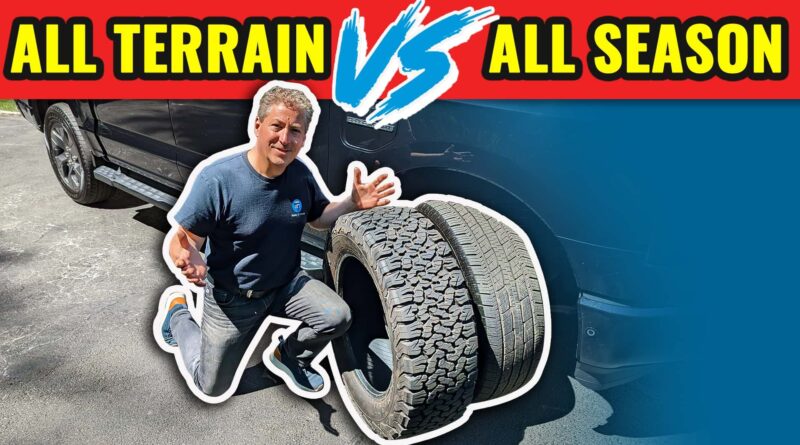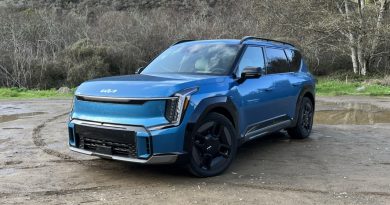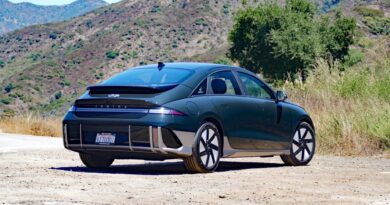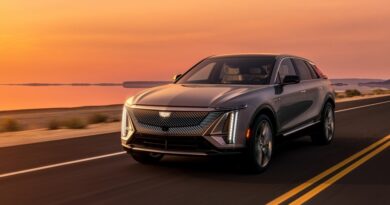Ford F-150 Lightning Tire Comparison: All Season vs All Terrain
We range-tested a 2022 Ford F-150 Lightning with the stock General Grabber all-season tires and also with aftermarket BFGoodrich K02 all-terrain tires to see how much difference in range the aggressive tread of the all-terrain tires would make.
It’s no secret that tires play an important role in vehicle efficiency, and that goes for combustion vehicles the same as it does for EVs. However, since electric vehicles have less driving range and require a longer time to recharge, some owners are less likely to add an aftermarket item that will significantly reduce the vehicle’s driving range. One of the most asked questions I get from other F-150 Lightning owners is: how much range will I lose by adding all-terrain tires?

F-150 Lightning range test comparison: BFGoodrich K02 all-terrain vs General Grabber all-season tires
A few weeks ago I did a side-by-side range test comparing my Rivian R1T with my F-150 Lightning. When I did that test, I had BFGoodrich K02 tires on the Lightning, which I put on for the winter months. I’ve had K02s on many of my previous trucks and they are my favorite all-terrain tire for overall performance and tread life.
I wanted to do that comparison range test with all-terrain tires on the Lightning because the R1T had all-terrain tires on it, and it wouldn’t be a fair range test if one vehicle has all-season tires and the other had all-terrain.
The EPA range rating for the R1T is 39 miles less (289 mi vs 328 mi) when it has the 20″ all-terrain tire/wheel option that I had, versus the 21″ all-season tires/wheel combo. The EPA range rating for my Lightning is 320 miles, but that’s with the all-season tires that are standard. Ford offers an all-terrain tire option for the Lightning, but the tread isn’t very aggressive and Ford didn’t have to submit a separate EPA range filing because the range penalty between the two options is not significant.

The Rivian was the clear winner in the head-to-head comparison, despite having a smaller battery and weighing less than the Lightning, and finished up with 14% more state of charge. I suspect the two main factors that gave the R1T the edge were its aerodynamics are better and it has an eco-driving mode, called Conserve. In Conserve mode, Rivian vehicles decouple the rear motors, and the vehicle drives in front-wheel-drive, resulting in a lower energy consumption rate.
The Lightning doesn’t offer an “eco” driving mode, so I did both range tests in the “Normal” driving mode, which is the most efficient.
In the first range test with the BFGoodrich K02 all-terrain tires, I drove 255.7 miles and finished up with 1% state of charge and 3 miles of estimated remaining range. On the second trip with the stock General Grabber all-season tires, I finished the trip with 256 miles driven and the truck was at 9% state of charge with 25 miles of remaining range.
Therefore, the BFGoodrich K02 tires cost me 8% of the battery which translated to 22 fewer miles of estimated driving range. I want to note that I drove on the same exact course and in nearly identical driving conditions (temperature, wind, traffic) with the tire pressure and climate control set the same in both tests.
More and more tire manufacturers are beginning to sell EV-specific tires that are designed to increase the driving range. The InsideEVs podcast sponsor, ERange Tires is the first entire tire line that was specifically designed, constructed, and tested for electric vehicles. They currently don’t offer the tire size I need for the Lightning, but when they do, I plan on buying them to see how they compare on the same course that I tested the K02s and the Grabbers.
Source : Autonews.com




